5 Best Practices to Optimize Logo Images for WordPress Themes
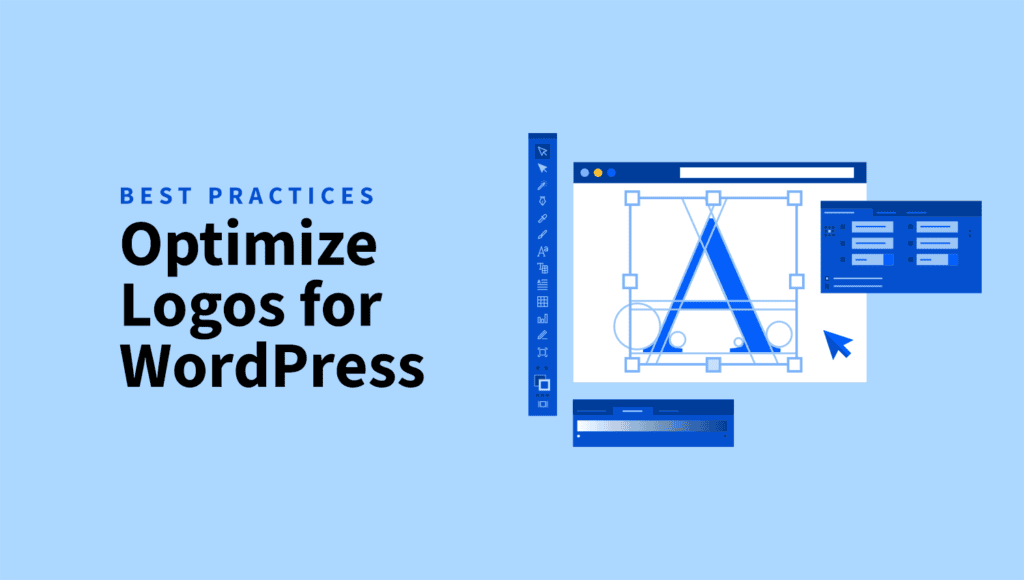
You must be shocked when someone tells you to optimize logo images. It must’ve felt wild!
Do I even need to optimize these tiny logo images?
Well, yes!
Adobe prefers your website logo images to be under 200 KB. That’s because a logo image repeatedly appears on the same page.
Say your website logo image is 350 KB and appears 3 times. That’s 1.05 MB extra weight on your page apart from every other content and image.
If you are designing your website and considering optimizing it, you should be concerned about optimizing your logo images.
In this article, we will share some of the best practices to optimize logo images in WordPress.
Let’s dive deep!
Quick Takeaways
- Optimizing logo images is essential because they can contribute to page weight.
- It is recommended that logo images be kept under 200 KB. Larger logos harm user experience, SEO performance, and page load times, especially when they appear repeatedly.
- Best practices for logo optimization include picking the right size, choosing formats like PNG or SVG for sharpness and scalability, compressing files to reduce weight without sacrificing quality, and optimizing for SEO with descriptive file names, alt text, and appropriate meta-tags.
Why Should You Optimize Logo Images in WordPress?
Even the tiniest WordPress logo images can have an impact on your website. So, let’s get into why you should optimize logo images:
Performance: Logo images, like all images, take up space. But, these small logos can take up more space because they appear multiple times on the same web page. That creates a considerable weight on that page. Overweight web pages slow down, and slow page loading raises your site’s bounce rate.
UX: User experience is the key to a successful online business. A slow page loading speed hurts website performance and user experience. 47% of users expect websites to load in 2 seconds. Thus, optimize logo images as well for fast loading.
SEO: Visual elements are an important part of any SEO campaign. Image search returns 27.9% of all Google search queries. Thus, optimize your images, including logos, if you want many search engine visitors. Besides, you must optimize logo image for search engines to identify it.
5 Best Practices to Optimize Logo Images For WordPress Themes
Optimizing everything within your website keeps it healthy. The same goes for even the tiny logo images. It improves user experience, raises SEO rankings, and maintains consistent branding.
Let’s go over the top 5 best practices to optimize logo images in WordPress themes:
Pick the Correct WordPress Logo Size
Your company’s logo is its public face. Since it can make or break an impact, you need to optimize it properly, particularly its size.
Whether you created it using logo makers or had it designed by a professional, if your company’s logo is too small, it will appear blurry on your website. Choosing the right logo size ensures it remains sharp, clear, and easily visible, providing a polished look for your site.
If the logo is too large, the web page’s loading time will be prolonged due to the larger file size. It will hurt your website’s overall performance.
Also, a giant logo occupies too much space in the navigation bar. Thus, it slows navigation and makes the browsing experience worse.
What is The Ideal WordPress Website Logo Size?
- The ideal WordPress website logo size is 250 x 150 pixels. Your layout can be vertical or horizontal.
- The suggested length for a vertical layout is 160 x 160 pixels.
- Horizontal layouts should be 250 x 150 pixels, 350 x 75 pixels, or 400 x 100 pixels in size.
Each WordPress theme has its own suggested logo size.
It’s best to choose a size that matches the theme’s recommendations. It ensures that your logo looks great on your website.
How to Change Logo Size in WordPress?
Step 1: Navigate to WordPress dashboard > Appearance > Customize > Header > Logo. Different WordPress themes function differently. The navigation could be a little different for your WordPress theme. Here, we used the Astra WordPress theme.
Step 2: Adjust logo Width. Astra only allows to change the WordPress logo Width. You can adjust the pixels and reset to default if you change your mind.
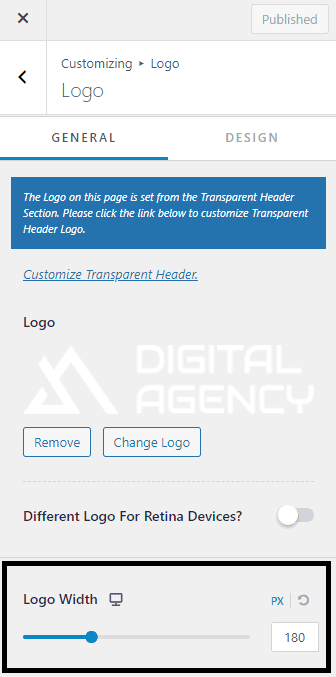
Step 3: Change the color and Space Margin from the Design menu if you need.
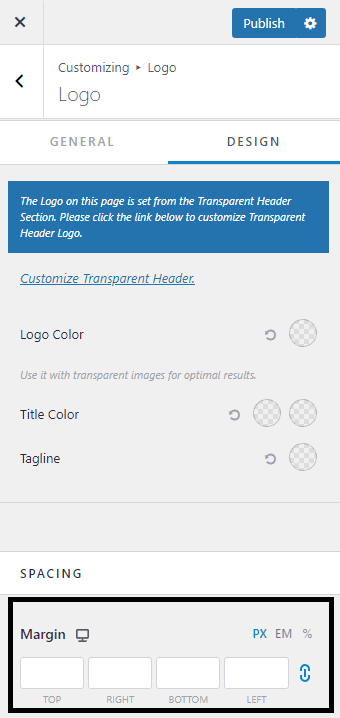
Choose a Suitable Logo Image Format
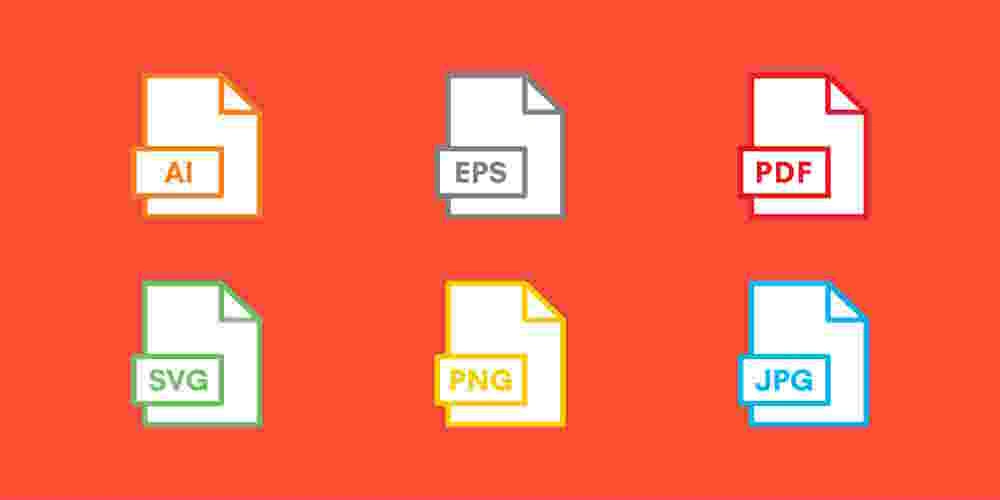
The image format determines the visibility of your website’s logo. It ensures that the logo appears crisp and clear on all devices. Thus, a proper and appropriate image format is needed for logos.
If you use an image format that loses quality when scaled, the logo will not look sharp on all screen sizes. For instance, JPEG images lose quality and transparency, making them unsuitable for logos.
Since some image formats degrade when scaled, logo scalability depends on the format. But, some image formats maintain image quality after scaling. So select an image format that preserves image quality after editing and scaling.
Moreover, the image format ensures transparency. Not all image formats support transparent backgrounds. Besides, you must choose a transparent file format for the logo on different backgrounds.
Which Image Format is The Best For WordPress Logos?
PNG
PNG is the most popular and recommended image format for WordPress logos. It supports transparent backgrounds and keeps quality after compression. It also retains sharpness and clarity across all devices. However, its file size is larger than other popular formats such as JPEG.

SVG
SVG is yet another excellent image format for WordPress logos. It’s a vector file format, which means it retains its quality when scaled or edited. It looks clear on any device because it supports transparent backgrounds.
SVG images have a smaller file size than PNG files. WordPress supports both of these formats. So you can pick whatever format you want. Do some assessments, and select the best fits your needs.
Use Compression for Faster Loading Logo Images
Larger logo files hurt website performance.
Yes! They do, unfortunately.
The logo is the most used image on your website and comes repeatedly.
Larger logo files also take longer to load. Thus, some page loading and UX negativity impact your site’s performance. It also raises a significant issue.

Compressing images can cut file sizes by 90%. Thus, reducing image files speeds up your WordPress website loading. This boosts complete website performance.
There are two types of image compression:
- Lossy compression significantly reduces file size but loses image quality.
- Lossless compression, unlike lossy compression, does not reduce the image quality. But it does result in larger file sizes.
Lossless compression is best for logo preservation. You can use the ShortPixel online image compression tool to compress logo images.
Free online image compressor
Compress logo designs online for free using a simple and straightforward tool.
It significantly reduces the image size, but its cutting-edge algorithm also preserves image quality.

Optimize Logo Images For SEO in WordPress
One of your primary traffic sources is search engines. Forbes says that 68% of online experiences begin with search engines. Thus, you should optimize every WordPress image SEO factor, including logo image SEO.
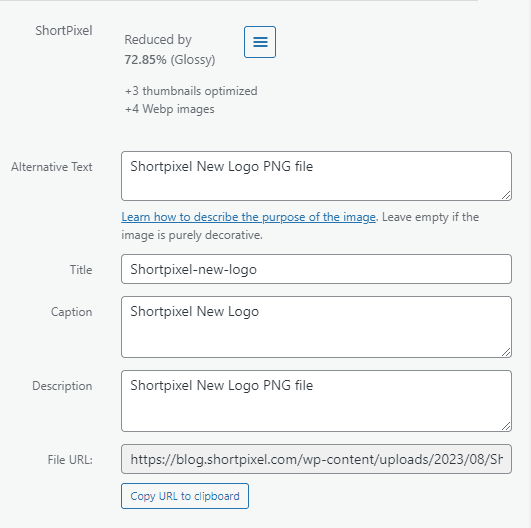
Since the image is essential for SEO, you must optimize it on various parameters. Here are some tips to optimize logo images for SEO.
Optimize Logo Image File Name
Use descriptive names. Use keywords that represent the image’s content and context.
Avoid using generic labels like image123.jpg. Instead, use hyphens to separate words, as in blue-sunset-beach.jpg.
Keep file names short but descriptive. Keywords in file names increase image search visibility. Besides, it provides the audience with a clear understanding.
Optimize Logo Image Alt Tag
Create clear, meaningful alt text so the reader can understand the image without looking at it. Alt text should be written as if you were explaining the image to a blind person.
Focus on clarity and precision, avoiding keyword stuffing. It improves both SEO and web accessibility for users with visual impairments.
Alt helps search engines understand the image’s relevance to the surrounding content. Please don’t overlook it; it’s crucial.
Optimize Logo Image Title
WordPress uses file names for image titles. If these titles need clarification, use file-naming keywords. Image titles enhance alt text context but are less critical for WordPress SEO.
Add a Logo Image Caption
Image caption below the image. It doesn’t affect WordPress SEO directly. But, unlike file names and alt text, the caption is visible.
The rules of modern WordPress SEO are constantly changing. We are racing towards an AI-controlled SEO world. So, you should keep everything optimized there.
It influences the user experience of a website. But it could indirectly boost SEO by improving user experience.
Optimize Logo Image Meta Tags
Image meta-tags are the metadata that describe images. It includes image location, date, and camera model and settings. It also contains copyright information.
These tags help to access, organize, and store images on different parameters—stored in the EXIF file format.
You can improve image meta-tags by including relevant image information. EXIF file viewers and photo editors can add these meta-tags to your images.
Meta-tags take up a percentage of image size. Yet, it’s insignificant. But you can remove unnecessary meta-tags to keep it clean.
Thus, the logo will load faster than before. To remove unnecessary meta-tags, use Photoshop or EXIF file editing software.
Summary
Every microsecond of loading speed counts in this competitive market. As every image takes up space, you need to optimize every image, let alone logo images.
Every WordPress theme has its specifications. So, it would help if you balanced the sizes when optimizing logo images for WordPress themes.
Besides, you must maintain image quality to make the logo visible, precise, and clear. Otherwise, your visitors will leave your website.
How do you like these logo image optimization methods? Is there anything else we missed?
Please share your best logo image optimization methods and thoughts.
FAQs
What size should a logo be in WordPress?
The ideal logo WordPress size is around 200-250 width. However, make sure to check your theme’s specific recommendations for the best results.
Does WordPress optimize images?
Yes, WordPress does optimize JPEG images during upload, but this optimization is actually a reduction in quality. For better results without noticeable quality loss, consider using plugins like ShortPixel Image Optimizer.
Why does WordPress reduce image quality?
WordPress reduces JPEG image quality to improve website performance. By reducing the quality, it decreases file sizes, which helps pages load faster and uses less server storage. This is especially important for maintaining speed and efficiency on websites with lots of media content. However, the downside is a slight drop in image clarity due to the compression process.
What is the resolution of a logo in WordPress?
The resolution of a logo in WordPress depends on the size guidelines of your theme. A standard resolution for most WordPress logos is 250 x 150 pixels.
What is a good resolution for a logo?
A good resolution for a logo is typically 72 DPI (dots per inch) for web use, as this ensures clarity while keeping the file size small. The dimensions should match the design purpose, such as 250 x 150 pixels for standard website logos.
What is the best format for WordPress logo?
The best format for a WordPress logo is PNG or SVG. PNG is ideal for maintaining sharpness, clarity, and transparency, especially on different backgrounds. SVG is great for scalability because it’s a vector format, ensuring the logo stays crisp at any size. Both formats work well depending on your needs, but SVG is preferred for scalability and smaller file sizes.